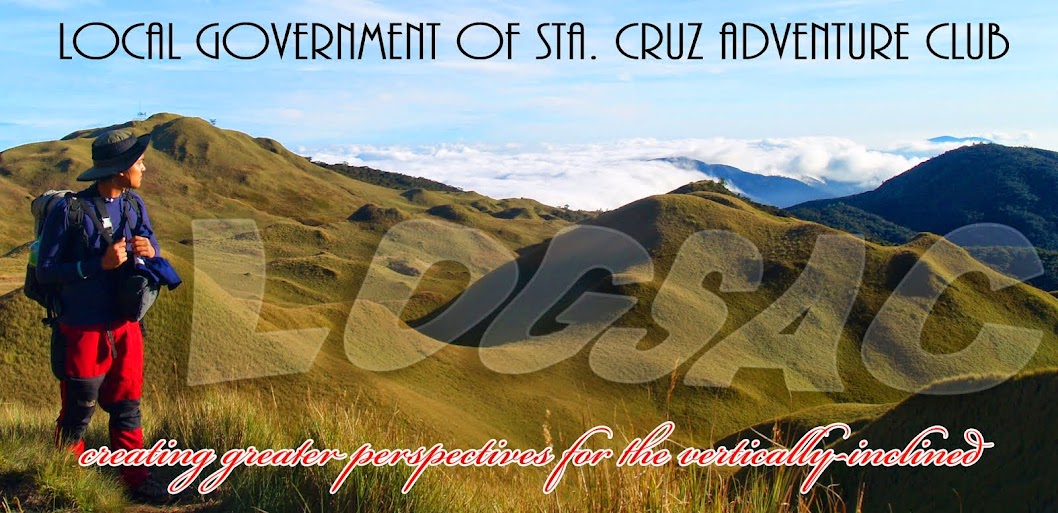LOGSAC’s Danrev Bronola (Papong) has scaled the North Base Camp of Mt. Everest last October 30-31, 2011. This side of the world’s highest peak measures up to 5,545 meters above sea level and 3,303 meters away from Everest summit. This camp is one of the basic campsites on Mount Everest that is used by mountain climbers during their ascent and descent. North Base Camp is used when climbing via the northeast ridge. Unlike the south base camp where climb necessities are carried by porters with the help of animals, the North Base Camp has vehicle access.

Papong’s climb was via the Tibet-side with consent from the Chinese government. He got the permit through an arranged travel package which included a transport vehicle, driver and guide for a group of guests.
“Being novice to alpine mountains, I really had hard time doing this climb,” said Papong, stressing that climbing EBC presents dangers such as altitude sickness, weather and wind. He also pointed out that snow-filled mountains are a challenge to mountaineers who used to climbing tropical mountains like the Philippines.
The northridge base camp is made of plain gravel, just below the glacier formations. These glaciers are routes going to more North Face campsites going to the summit of Mt. Everest, a very treacherous track which includes a diagonal climb of Yellow Band.

When asked about the possibility of climbing Everest summit in the future, Papong could only say “mahal masyado….climbing Mt. Everest is an expensive undertaking.”
Of course, aside from the financial consideration, climbing Mt. Everest is very dangerous. There are even portions above the 8,000 meters elevation that are dubbed as the “death zone”. Temperatures can dip to very low levels, resulting in frostbite of any body part exposed to the air. Since temperatures are so low, snow is well-frozen in certain areas and death or injury by slipping and falling can occur. High winds at these altitudes on Everest are also a potential threat to climbers. Another significant threat to climbers is low atmospheric pressure. The atmospheric pressure at the top of Everest is about a third of sea level pressure, resulting in the availability of only about a third as much oxygen to breathe.

By the end of 2010 Everest had claimed 219 lives, including eight who perished during a 1996 storm high on the mountain. Conditions are so difficult in the death zone that most corpses have been left where they fell. Some of them are visible from standard climbing routes.
Here is the rest of my interview with Papong.
What are the motivations that made you decide to go to EBC? Basically it’s the idea to really try a snow mountain. Kasi parang halos lahat ng bundok sa Pilipinas napuntahan na natin and they all shared the same characteristics eh considering that they are all located in a tropical location.
Based on your experience, what are the hardships of being exposed to alpine mountains? First is the temperature, sobrang lamig talaga I even suffered minor nose bleeding. Second is the very thin oxygen content considering the altitude, kung hindi talaga kaya, the guides would recommend oxygen supplementation.
Which do you prefer climbing, tropical mountains or snow mountains? Tropical. Syempre Masaya pa rin dito sa atin. The company, the jungle trail, the normal temperature and everything….Yung preparations in climbing tropical mountains are very basic for us kasi sanay na tayo.
If given the chance, would you proceed to Mt. Everest Summit? Definitely yes. Ang kailangan lang talaga sa Everest is financial resources, the rest will just follow. Kung may pera ka, lahat mapaghahandaan eh…physical preparation, the equipment, guides, lahat ng bagay pwedeng paghandaan at gawin.
To whom do you dedicate this climb? Actually hindi naman siya talaga matatawag na major climb kasi wala masyadong trekking eh, yung North Base Camp na pinuntahan namin we were assisted by a vehicle, konti na lang ang trekking. Mas mahaba pa nga ang travel time namin eh. Still, I would like to dedicate it to my LOGSAC mates, para sa inyo ito guys and to all the mountaineers in Mindanao.
 Lastly, what can you say about Philippine mountaineers who aspire to go to Mt. Everest?
Lastly, what can you say about Philippine mountaineers who aspire to go to Mt. Everest?Wala naman, basta may financial resources sila kaya naman eh. Preparation lang konti sa weather doon. Yung BMC natin dito applicable pa rin dun except sa other areas of concerns.



















































